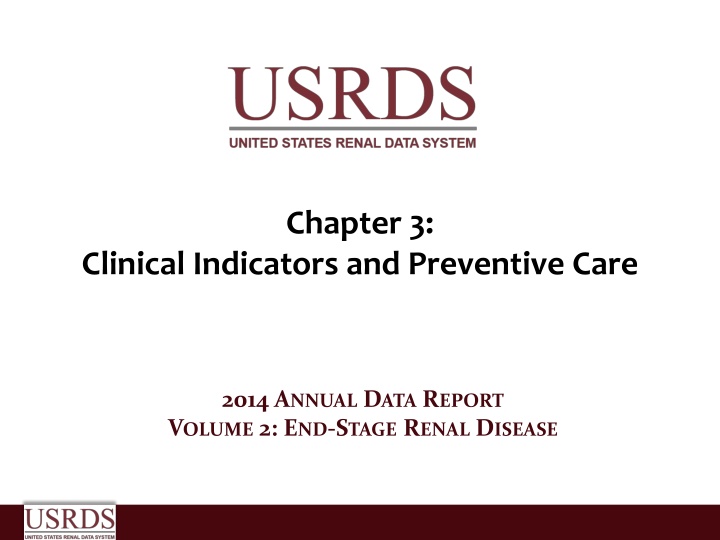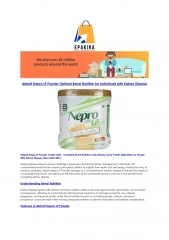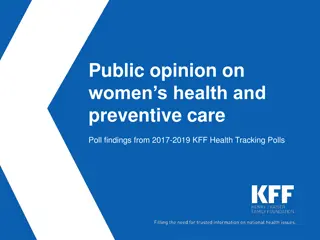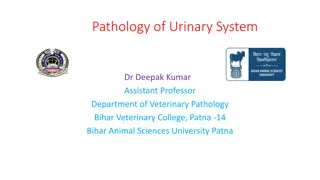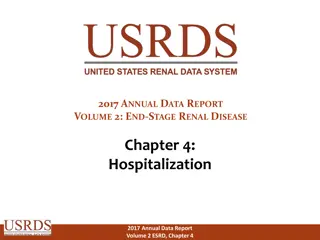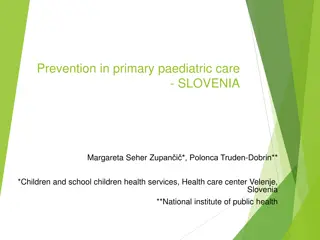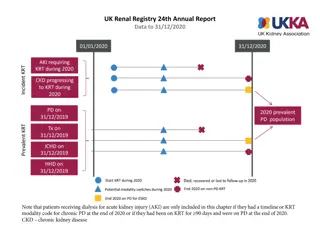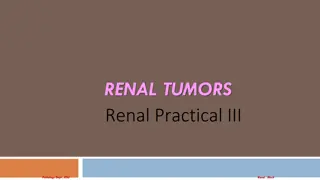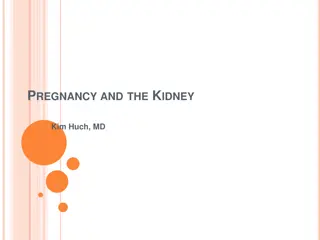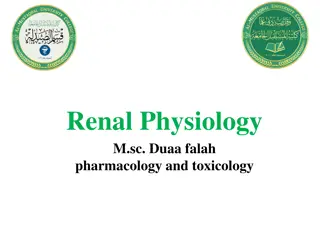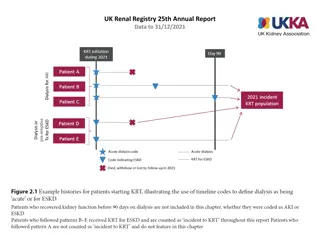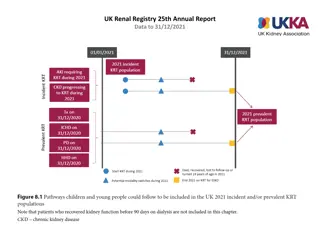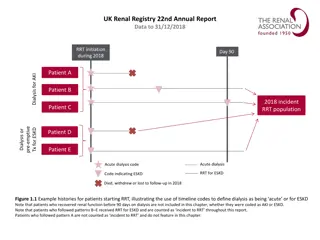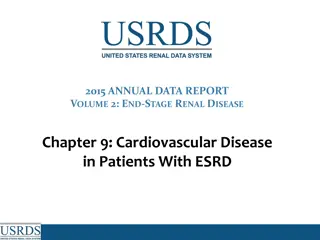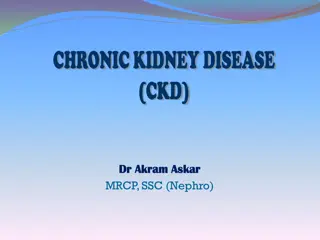Clinical Indicators and Preventive Care for End-Stage Renal Disease
The report presents clinical indicators, including dialysis adequacy, hemoglobin levels, and vascular access distribution among patients with end-stage renal disease. It highlights data on prevalent patients meeting clinical care guidelines and trends in mean hemoglobin levels and EPO dosages in adult HD patients.
Uploaded on Feb 28, 2025 | 2 Views
Download Presentation

Please find below an Image/Link to download the presentation.
The content on the website is provided AS IS for your information and personal use only. It may not be sold, licensed, or shared on other websites without obtaining consent from the author.If you encounter any issues during the download, it is possible that the publisher has removed the file from their server.
You are allowed to download the files provided on this website for personal or commercial use, subject to the condition that they are used lawfully. All files are the property of their respective owners.
The content on the website is provided AS IS for your information and personal use only. It may not be sold, licensed, or shared on other websites without obtaining consent from the author.
E N D
Presentation Transcript
Chapter 3: Clinical Indicators and Preventive Care 2014 ANNUAL DATA REPORT VOLUME 2: END-STAGE RENAL DISEASE
vol 2 Figure 3.1(a) Clinical indicators: Percentage of prevalent patients meeting clinical care guidelines on dialysis adequacy, percentage distribution of achieved mean Hgb among prevalent HD and PD patients, and percentage distribution of VA among prevalent HD patients, from CROWNWeb data Data Source: CROWNWeb clinical extracts for December 2013. Panel a: Dialysis patients initiating treatment for ESRD at least 1 year before December 1, 2013, and who were alive through December 31, 2013. Abbreviations: ESRD, end-stage renal disease; HD, hemodialysis; Hgb, hemoglobin; Kt/V, see Glossary; PD, peritoneal dialysis; URR, urea reduction ratio; VA, vascular access. Vol 2, ESRD, Ch 3 2
vol 2 Figure 3.1(b) Clinical indicators: Percentage of prevalent patients meeting clinical care guidelines on dialysis adequacy, percentage distribution of achieved mean Hgb among prevalent HD and PD patients, and percentage distribution of VA among prevalent HD patients, from CROWNWeb data Data Source: CROWNWeb clinical extracts for December 2013. Panel b: Dialysis patients initiating treatment for ESRD at least 90 days prior to December 1, 2013, who were 18 years old as of December 1, 2013, and who were alive through December 31, 2013. Abbreviations: ESRD, end-stage renal disease; HD, hemodialysis; Hgb, hemoglobin; Kt/V, see Glossary; PD, peritoneal dialysis; URR, urea reduction ratio; VA, vascular access. Vol 2, ESRD, Ch 3 3
vol 2 Figure 3.1(c) Clinical indicators: Percentage of prevalent patients meeting clinical care guidelines on dialysis adequacy, percentage distribution of achieved mean Hgb among prevalent HD and PD patients, and percentage distribution of VA among prevalent HD patients, from CROWNWeb data Data Source: CROWNWeb clinical extracts for December 2013. Panel c: HD patients initiating treatment for ESRD at least 90 days prior to December 1, 2013, who were 18 years old as December 1, 2013, and who were alive through December 31, 2013. Abbreviations: ESRD, end-stage renal disease; HD, hemodialysis; Hgb, hemoglobin; Kt/V, see Glossary; PD, peritoneal dialysis; URR, urea reduction ratio; VA, vascular access. Vol 2, ESRD, Ch 3 4
vol 2 Figure 3.2(a) Mean monthly Hgb level and mean weekly EPO dose (monthly average, expressed in units/week) in adult HD patients on dialysis 90 days, from Medicare claims: time trend from 1995-2012 Data Source: Special analyses, USRDS ESRD Database. Panel a: Mean monthly Hgb level among ESA-treated HD patients within a given month (1995 through 2012) or all HD patients irrespective of ESA use (April to December 2012 only) if, within the given month, the patient had an Hgb claim, was on dialysis 90 days, and was 18 years old at the start of the month. Mean monthly EPO (epoetin alfa) dose among HD patients within a given month who had an EPO claim, were on dialysis 90 days, and were 18 years old at the start of the month. EPO dose is expressed as mean EPO units per week averaged over all EPO claims within a given month. Abbreviations: EPO, erythropoietin; ESA, erythropoiesis-stimulating agents; HD, hemodialysis; Hgb, hemoglobin; IV, intravenous. Vol 2, ESRD, Ch 3 5
vol 2 Figure 3.2(b) Monthly IV iron use in adult HD patients on dialysis 90 days, from Medicare claims: time trend from 2005-2012 Data Source: Special analyses, USRDS ESRD Database. Panel b: Monthly IV iron use among HD patients on dialysis 90 days and 18 years old at the start of the given month. Abbreviations: EPO, erythropoietin; ESA, erythropoiesis-stimulating agents; HD, hemodialysis; Hgb, hemoglobin; IV, intravenous. Vol 2, ESRD, Ch 3 6
vol 2 Figure 3.3 Distribution of monthly Hgb (g/dL) levels in ESA-treated adult HD patients on dialysis 90 days, from Medicare claims: time trend from 1995-2012 Data Source: Special analyses, USRDS ESRD Database. Patient distribution among HD patients within a given month who had claims for Hgb level and ESA use, were on dialysis 90 days, and were 18 years old at the start of the month. Abbreviations: ESA, erythropoiesis-stimulating agents; HD, hemodialysis; Hgb, hemoglobin. Vol 2, ESRD, Ch 3 7
vol 2 Figure 3.4 Percentage of adult HD patients with 1 claim for an RBC transfusion in a month, from Medicare claims data, by race: monthly time trend from 2010-2012 Data Source: Special analyses, USRDS ESRD Database. The percentage of HD patients 18 years old at the start of the month with 1 RBC transfusion claim in a given month among HD patients having a claim for at least one dialysis session during the month. Abbreviations: HD, hemodialysis; RBC, red blood cell. Vol 2, ESRD, Ch 3 8
vol 2 Figure 3.5(a) Mean monthly Hgb level and mean weekly EPO dose (monthly average, expressed in units/week) in adult PD patients on dialysis 90 days, from Medicare claims: time trend from 1995-2012 Data Source: Special analyses, USRDS ESRD Database. Panel a: Mean monthly Hgb level among ESA-treated PD patients within a given month (1995 through 2012) or all PD patients regardless of ESA use (April to December 2012 only) if, within the given month, the patient had an Hgb claim, was on dialysis 90 days, and was 18 years old at the start of the month. Mean monthly EPO (epoetin alfa) dose was among PD patients within a given month who had an EPO claim, were on dialysis 90 days, and were 18 years old at the start of the month. EPO dose is expressed as mean EPO units per week averaged over all EPO claims within a given month. Abbreviations: EPO, erythropoietin; ESA, erythropoiesis-stimulating agents; Hgb, hemoglobin; IV, intravenous; PD, peritoneal dialysis. Vol 2, ESRD, Ch 3 9
vol 2 Figure 3.5(b) Monthly IV iron use in adult PD patients on dialysis 90 days, from Medicare claims: time trend from 2005-2012 Data Source: Special analyses, USRDS ESRD Database. Panel b: Monthly IV iron use is among PD patients on dialysis 90 days and 18 years old at the start of the given month. Abbreviations: EPO, erythropoietin; ESA, erythropoiesis-stimulating agents; Hgb, hemoglobin; IV, intravenous; PD, peritoneal dialysis. Vol 2, ESRD, Ch 3 10
vol 2 Figure 3.6 Distribution of monthly hemoglobin (g/dL) levels in ESA-treated adult ( 18 years of age) peritoneal dialysis patients on dialysis 90 days, from Medicare claims: time trend from 1995-2012 Data Source: Special analyses, USRDS ESRD Database. Distribution of Hgb levels among PD patients within a given month who had claims for Hgb level and ESA use, were on dialysis 90 days, and were 18 years old at the start of the month. Abbreviations: ESA, erythropoiesis-stimulating agents; Hgb, hemoglobin; PD, peritoneal dialysis. Vol 2, ESRD, Ch 3 11
vol 2 Figure 3.7 Percentage of adult PD patients 18 years old with 1 claim for RBC transfusion in a month, from Medicare claims data, by race: monthly time trend from 2010-2012 Data Source: Special analyses, USRDS ESRD Database. The percentage of PD patients with 1 RBC transfusion claim in a given month was among PD patients having a claim for at least one dialysis session during the month, and who were 18 years old at the start of the month. Abbreviations: PD, peritoneal dialysis; RBC, red blood cell. Vol 2, ESRD, Ch 3 12
vol 2 Figure 3.8 Diabetes-related care among patients with diabetes mellitus 18-75 years old with ESRD, from Medicare claims: time trend from 1999-2012 Data Source: Special analyses, USRDS ESRD Database. Point prevalent Medicare ESRD patients ages 18 to 75 with a diagnosis claim for diabetes mellitus in the previous year; diabetes-related care in the measurement year. Abbreviations: ESRD, end-stage renal disease. Vol 2, ESRD, Ch 3 13
vol 2 Figure 3.9 Percentage of ESRD patients with a claim for seasonal influenza vaccination (August 1-April 30 of subsequent year) based on Medicare data, overall: time trend from 2002-2012 Data Source: Special analyses, USRDS ESRD Database. ESRD patients initiating treatment for ESRD at least 90 days before seasonal period: August 1-April 30 for influenza. Abbreviations: ESRD, end-stage renal disease. Vol 2, ESRD, Ch 3 14
vol 2 Figure 3.10 Percentage of ESRD patients with a claim for seasonal influenza vaccination (August 1-April 30 of subsequent year) based on Medicare data, by age: time trend from 2002-2012 Data Source: Special analyses, USRDS ESRD Database. ESRD patients initiating treatment for ESRD at least 90 days before seasonal period: August 1-April 30 for influenza. Abbreviations: ESRD, end-stage renal disease. Vol 2, ESRD, Ch 3 15
vol 2 Figure 3.11 Percentage of ESRD patients with a claim for seasonal influenza vaccination (August 1-April 30 of subsequent year) based on Medicare data, by race/ethnicity: time trend from 2002-2012 Data Source: Special analyses, USRDS ESRD Database. ESRD patients initiating treatment for ESRD at least 90 days before seasonal period: August 1-April 30 for influenza. Abbreviations: Af Am, African American; ESRD, end- stage renal disease; Nat Am, Native American. Vol 2, ESRD, Ch 3 16
vol 2 Figure 3.12 Percentage of ESRD patients with a claim for seasonal influenza vaccination (August 1-April 30 of subsequent year) based on Medicare data, by modality: time trend from 2002-2012 Data Source: Special analyses, USRDS ESRD Database. ESRD patients initiating treatment for ESRD at least 90 days before seasonal period: August 1-April 30 for influenza. Abbreviations: ESRD, end-stage renal disease; HD, hemodialysis; PD, peritoneal dialysis; Tx, transplant. Vol 2, ESRD, Ch 3 17
vol 2 Figure 3.13 VA use among HD patients at initiation of ESRD treatment, from the ESRD Medical Evidence Form (CMS 2728): time trend from 2005-2012 Data Source: Special analyses, USRDS ESRD Database. ESRD patients initiating HD in 2005-2012. Abbreviations: AV, arteriovenous; ESRD, end-stage renal disease; HD, hemodialysis; VA, vascular access. Vol 2, ESRD, Ch 3 18
vol 2 Table 3.1 VA at HD initiation in year 2012, by patient characteristics from the ESRD Medical Evidence Form (CMS 2728) AV fistula used or maturing AVF in place AV graft used or maturing AVG in place Catheter alone All 34.6 4.8 60.6 Age 0-19 14.3 2.3 83.4 20-44 31.0 3.5 65.5 45-64 36.2 4.4 59.4 65-74 36.7 5.3 58.0 75+ 31.9 5.5 62.6 Sex Male 36.9 3.8 59.3 Female 31.5 6.2 62.3 Race/Ethnicity White 35.0 4.0 61.0 Black/African American 34.3 6.9 58.8 Native American 39.3 3.8 56.9 Asian 35.9 5.2 58.9 Hispanic 32.7 3.8 63.6 Data source: Special analyses, USRDS ESRD Database. Abbreviations: AV, arteriovenous; AVF, arteriovenous fistula; AVG, arteriovenous graft; ESRD, end-stage renal disease; HD, hemodialysis; VA, vascular access. Vol 2, ESRD, Ch 3 19
vol 2 Table 3.1 VA at HD initiation in year 2012, by patient characteristics from the ESRD Medical Evidence Form (CMS 2728) AV fistula used or maturing AVF in place AV graft used or maturing AVG in place Catheter alone All 34.6 4.8 60.6 Primary Cause of ESRD Diabetes 38.4 5.2 56.4 Hypertension 34.0 5.1 60.9 Glomerulonephritis 33.8 4.2 62.0 Cystic kidney 57.2 5.0 37.8 Other urologic 34.3 4.6 61.1 Other cause 20.1 3.2 76.7 Unknown/missing 24.0 4.0 72.0 Comorbidities Diabetes 36.3 5.0 58.7 Congestive heart failure 32.7 4.7 62.5 Atherosclerotic heart disease 37.0 5.1 57.9 Cerebrovascular disease 34.0 6.3 59.7 Peripheral vascular disease 35.5 4.7 59.8 Hypertension 35.7 4.9 59.4 Other cardiac disease 32.0 4.7 63.3 Data source: Special analyses, USRDS ESRD Database. Abbreviations: AV, arteriovenous; AVF, arteriovenous fistula; AVG, arteriovenous graft; ESRD, end-stage renal disease; HD, hemodialysis; VA, vascular access. Vol 2, ESRD, Ch 3 20
vol 2 Figure 3.14 Geographic variation in percentage of catheter alone use at HD initiation, in year 2012, from the ESRD Medical Evidence Form (CMS 2728) Data Source: Special analyses, USRDS ESRD Database. ESRD patients initiating HD in 2012. Abbreviations: ESRD, end-stage renal disease; HD, hemodialysis. Vol 2, ESRD, Ch 3 21
vol 2 Figure 3.15 VA use during the first year of HD by time since initiation of ESRD treatment, among patients new to HD in 2012, from the ESRD Medical Evidence Form (CMS 2728) and CROWNWeb data Data Source: Special analyses, USRDS ESRD Database and CROWNWeb. ESRD patients initiating HD in 2012. Abbreviations: ESRD, end-stage renal disease; HD, hemodialysis; VA, vascular access. Vol 2, ESRD, Ch 3 22
